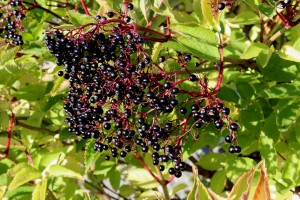Of all the berries in the countryside at the moment the most conspicuous are the rowan berries. With such a heavy harvest of them this year and the thrushes from Scandinavia still to raid them they tend to dominate the scene. However, there is a good crop of brambles, some people call them blackberries, and wild raspberries. On the downward side some readers have reported a poor year for sloes on the blackthorn bushes with some having no berries at all. There is one source of berry that we often overlook for some reason, despite how widespread they are, and it is the elderberries. Perhaps one of the reasons we overlook elder is they are normally smaller than many other trees and rarely dominate the scene. Despite this, elderberries are an important source of food for wide variety of birds and we have exploited the tree in very many ways.
From a culinary point of view it is one of the main subjects in that classic of Richard Mabey’s “Food for Free” first published in 1972. It is amazing that this book has never been out of print since and that is despite the large number of books on the subject in recent years. My favourite edition of this book is the large format, hardback Collins edition published in 2012. Interestingly, the photograph that takes up the whole of the front and back cover is of elderberries. Whilst the ripe umbels of berries at this time of the year may not be that conspicuous that cannot be said of, earlier in the year, the blossoms. By the end of June the whole shrub is covered with great sprays of sweet-smelling flowers, for which as Mabey puts it “ there are probably more uses than any other species of blossom”. The range of culinary uses of both blossoms and berries are extensive from elderflower cordial to various berry sauces.
 From a wildlife point of view elderberries are an excellent source of food for a wide variety of birds and mammals. As far as birds are concerned, around twenty different types have been seen taking the berries. These vary from woodpigeons to blue tits and blackbirds to robins. One of the main birds feeding on such berries are, perhaps surprisingly, starlings, and they descend in sometimes large parties and strip the bushes starting from the top and methodically working down. For some reason they tend to leave the lower ones and you can get elders with just a fringe of berries around the lower branches. A wide range of mammals feed on elderberries from mice to even pine martens. The pine martens sometimes venture out onto the branches to get at the clusters of berries. Both birds and mammals will readily take any berries that have fallen to the ground, particularly after high winds. Elder will readily colonise disturbed ground and I took the photograph of the elderberries on a bush on the side of a road where road works had taken place a few years ago. One of myths about the elder is that badgers prefer them to sharpen their claws and you can see elder bushes by badger setts that have been marked with vertical grooves in this way. It is not that badger simply favour elder but it is often the nearest trees to the sett. It grows there because elder flourishes in the high nitrogen content of the soil.
From a wildlife point of view elderberries are an excellent source of food for a wide variety of birds and mammals. As far as birds are concerned, around twenty different types have been seen taking the berries. These vary from woodpigeons to blue tits and blackbirds to robins. One of the main birds feeding on such berries are, perhaps surprisingly, starlings, and they descend in sometimes large parties and strip the bushes starting from the top and methodically working down. For some reason they tend to leave the lower ones and you can get elders with just a fringe of berries around the lower branches. A wide range of mammals feed on elderberries from mice to even pine martens. The pine martens sometimes venture out onto the branches to get at the clusters of berries. Both birds and mammals will readily take any berries that have fallen to the ground, particularly after high winds. Elder will readily colonise disturbed ground and I took the photograph of the elderberries on a bush on the side of a road where road works had taken place a few years ago. One of myths about the elder is that badgers prefer them to sharpen their claws and you can see elder bushes by badger setts that have been marked with vertical grooves in this way. It is not that badger simply favour elder but it is often the nearest trees to the sett. It grows there because elder flourishes in the high nitrogen content of the soil.
Tags: highland flora
